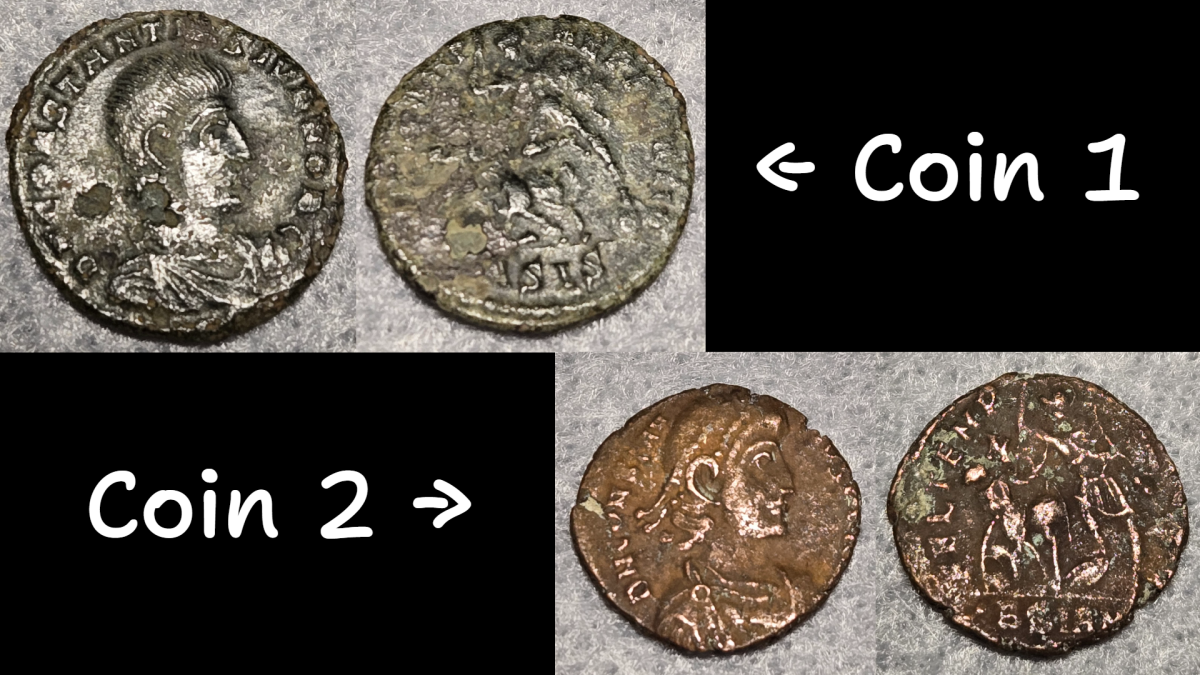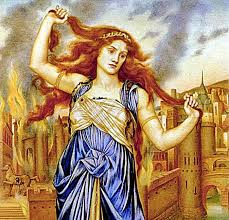First created in 650 B.C.E. near Miletus (1), the home of Thales (2), coins have become one of the most common forms of currency around the world. From the United States’ pennies to the ancient Roman denarius to Japanese yen, they are often used to represent smaller monetary amounts including one ‘cent’, twenty-five ‘cents’, fifty ‘cents’, and more. Because of the overall usefulness of these small, round pieces of metal, they are some of the most widely found artifacts in ancient archaeological sites, along with ceramics.
I was recently given two bronze coins by Dr. Molinari, our school librarian, from his collection (or randomly from his desk) and was tasked with finding where and when they were from. The first coin had a darker patina (3) and was pretty badly worn down. The second one was in a better condition and had more to go off of, so I started with that one.
I grabbed a magnifying glass and studied the coin to see if I could find any distinguishing marks on it like key words or symbols. On the reverse, or back side, I was able to make out the phrase “Fel Temp Reparatio” or “Restoration of Happy Times” in Latin.
Dr. Molinari also lent me a book called A Handbook of Late Roman Bronze Coin Types, 324-395 (4) written by Shawn M. Caza, which helped me tremendously in identifying the type of each coin and when they were possibly minted. I looked in the back of the book in the “Index of Reverse Legends” to try and see if there was something relating to “Fel Temp Reparatio.”
Luckily, there was an entire subheading related to the Latin phrase. Within the subheading, the author listed several different types of coins, including “Emperor Leading Barbarian From Hut” and “Falling Horseman.”
Upon looking closer at the back of the coin, I saw that one of the figures depicted looked like a horse, so I went to the “Falling Horseman” section (p. 175) and read more about it. As I browsed through the section, I started to realize that this was the correct direction, and an email from Dr. Molinari pretty much confirmed it too. The book offered several variations of this type of coin. The most plausible form to me would be “Horseman turning and reaching back to Emperor” or “Sub-type C” (p. 179) as it is labeled in the book.
From what I could make out from the inscriptions on the front and back of the second coin, I was able to further narrow down the mint location, which emperor it depicted, and generally when it was made. The actual “mint mark” (5) was too degraded for me to definitively determine where the coin was minted. From what I could see, the second coin was most likely minted in Rome for the Emperor Constantius II (6) around mid-349 to 358, but it’s hard to get more specific without asking a professional for their opinion.
From this research about the second coin, I went back to the first coin and saw that it was very similar to the second one. From what Dr. Molinari told me in an email, the coin with the darker patina, the first one, was minted around Slovenia. I looked at the mint mark on this coin, which was in better condition than the other one, and used the book (p. 168-172) to find places that used this specific mark, “ASIS.” It is possible that I could have read both mint marks completely incorrectly, but I am satisfied with what I came up with.
After browsing through the list of mint marks in the book, I found several variations of “ASIS.” In general, the book listed “ASIS” as being the mint mark of Siscia, a city in modern day Croatia. This is pretty close to where Dr. Molinari said the coin was found, Slovenia, being just about eighty miles apart from each other.
Overall, it was interesting to learn about the different types of coins, where they were from, and when they were possibly minted. I am grateful to Dr. Molinari for giving me this chance to discover more of the ancient world. I hope to do more like this in the future.
DEFINITIONS & FOOTNOTES
(1) Miletus: an ancient Greek city near the west coast of modern-day Türkiye (Turkey) where many philosophers were born.
(2) Thales: often seen as the first philosopher and scientist.
(3) Patina: a green or brown film on the surface of bronze or similar metals, produced by oxidation over a long period.
(4) A Handbook of Late Roman Bronze Coin Types, 324-395: written by Shawn M. Caza, originally published in 2021 by Spink. ISBN: 9781912667611, 1912667614.
(5) Mint mark: the letters that identify where a coin was made.
(6) Emperor Constantius II: Roman emperor from 337 to 340.























